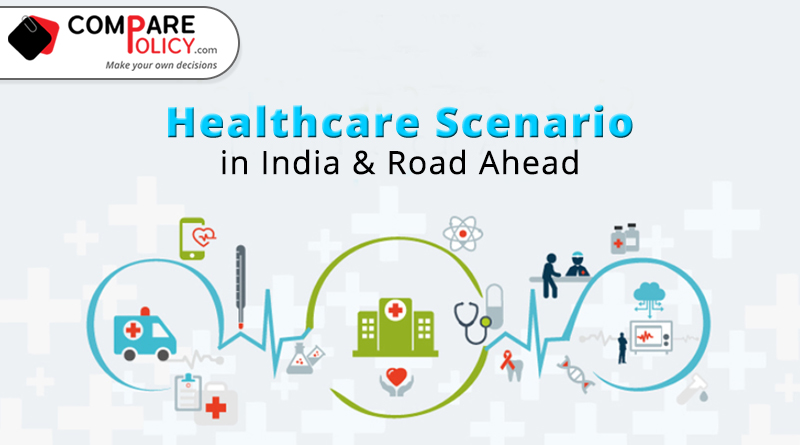Healthcare Scenario in India and Road Ahead- by Gajendra Nagpal, Insurance Consultant
India has achieved several noteworthy improvements in accessing quality health care services. Simultaneously, the healthcare sector is facing some tough challenges to deal with. It includes high out-of-pocket expenditure, low health insurance coverage, and low financial protection amongst both rural and urban populations.
Table Content
Challenges of Health Care System in India
In India, the health care system is lacking experienced & well-qualified doctors and basic infrastructure, due to which people are not able to access quality healthcare. The total count of allopathic doctors is just around 10 lakhs to treat the country’s population of 133 crore people. Out of the total doctors available, only 10% work in the public health sector.
There are just around 2 lakh hospitals which are largely concentrated around urban areas. However, 70% population of India (approx. 93 crore population) lives in rural areas, and to cater to their health care needs, there are 156,231 sub-centers, 25,650 Primary Health Centres, and 5,624 Community Health Centres.
India accounts for a large share of the world’s disease burden. As per a recent report from the India Council of Medical Research, the disease burden due to communicable, maternal, neonatal, and nutritional diseases is 33 percent and the disease burden from non-communicable diseases is 55 percent.
To tackle the Healthcare crisis in India, the healthcare industry needs to focus on making healthcare more affordable and easily accessible to the masses.
Health Insurance- Current Scenario
The majority of the population in the country is underinsured and resulting, they have to compromise on the quality of healthcare services.
- The per capita insurance expenditure on healthcare is the lowest in the world. More than 75% of Indians have no health insurance.
- The government is providing 88% of health insurance coverage serving the masses of the country.
- Huge urban-rural disparity, as far as health coverage is concerned.
- Due to inadequate coverage and lack of availability of public sector healthcare institutions, people have to cover over 60% of health-related expenses from their pocket.
Recent Achievements
Below given are the recent achievements of the government towards ensuring enhanced healthcare services to the people.
- National Nutrition Mission: In 2017, the Government of India approved the National Nutrition Mission (NNM), which aimed to tackle the problems of under-nutrition and low birth weight. This health program will make efforts to reduce stunting (impaired growth and development) from 38.4% to 25% by the year 2022.
- AMRIT Pharmacies: In 2017, 4.45 million patients benefitted from Affordable Medicines and Reliable Implants for Treatment (AMRIT) Pharmacies. AMRIT Pharmacies are proving to be a blessing for cancer patients. The medicines are provided to them at a discount of up to 80% on their MRP.
- National Medical Commission Bill: In 2017, the Government of India approved National Medical Commission Bill 2017, which seeks to regulate medical education and practice in India.
- Ayushman Bharat Scheme: The world’s largest government-funded healthcare scheme, Ayushman Bharat was launched on September 23, 2018. This health scheme will provide health cover of Rs 5 lakh per family and it will be available to 10.74 crores of poor, deprived rural families and identified occupational categories of urban workers’ families.
Way Ahead
The healthcare industry in India is one of the fast-growing sectors and it is expected to become a $280 billion industry by the year 2020. India’s healthcare sector is full of opportunities and businesses in this industry are exploring the ways that help them strengthen the medical services delivery to a greater proportion of the population. Moreover, the hospital industry is forecasted to become US$ 132.84 billion by FY’22 from US$ 61.79 billion in FY17 at a CAGR of 16-17%.
The government is making serious efforts to ensure people can easily avail quality healthcare services. The insurers are also expected to spread awareness of the importance of health insurance coverage. They must also launch health plans that cover the healthcare expenses of the entire family at an affordable premium, so everyone access healthcare without any worry of paying the medical bills.
Having adequate health coverage will enable you to access quality health care and you don’t need to worry about treatment expenses as well. Hospitals and medical centers must include technological advancements in treatment procedures to ensure better medical care for the patients. The medical facilities must focus on patient centricity and better healthcare services for all.
The author of this blog is Gajendra Nagpal, having rich experience in managing Insurance Business development in the online space.
You can contact him at: gajjunagpal@yahoo.com

